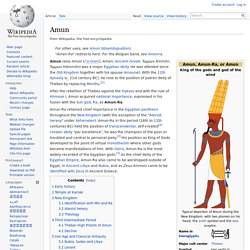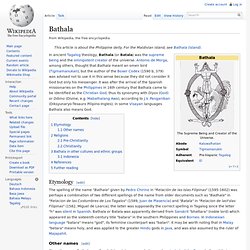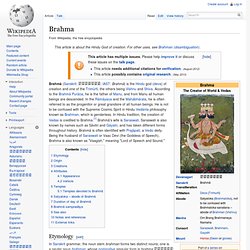

Ahura Mazda. Amun. "Amen Ra" redirects here.

For the Belgian band, see Amenra. Amun (also Amon (/ˈɑːmən/), Amen; Ancient Greek: Ἄμμων Ámmōn, Ἅμμων Hámmōn) was a major Egyptian deity. He was attested since the Old Kingdom together with his spouse Amaunet. With the 11th dynasty (c. 21st century BC), he rose to the position of patron deity of Thebes by replacing Monthu.[1] After the rebellion of Thebes against the Hyksos and with the rule of Ahmose I, Amun acquired national importance, expressed in his fusion with the Sun god, Ra, as Amun-Ra. Early history. Anguta. Anguta is the father of the sea goddess Sedna in Inuit mythology.

In certain myths of the Greenland Inuit Anguta (also called "His Father" or Anigut) is considered the creator-god and is the supreme being among of the Inuit people. In other myths, Anguta is merely a mortal widower. His name, meaning "man with something to cut," refers to his mutilating of his daughter which ultimately resulted in her godhood, an act he carried out in both myths. Angwusnasomtaka. Anu. In Sumerian mythology, Anu (also An; from Sumerian *An 𒀭 = sky, heaven) was a sky-god, the god of heaven, lord of constellations, king of gods, spirits and demons, and dwelt in the highest heavenly regions.

It was believed that he had the power to judge those who had committed crimes, and that he had created the stars as soldiers to destroy the wicked. His attribute was the royal tiara. His attendant and minister of state was the god Ilabrat. Sumerian religion[edit] Ur III Sumerian cuneiform for An(and determinative sign for deities see: DINGIR) Arinna. Arinna was the major cult center of the Hittite sun goddess, (thought to be Arinniti) known as dUTU URUArinna "sun goddess of Arinna".

Baal. Bronze figurine of a Baal, ca. 14th–12th century BC, found at Ras Shamra (ancient Ugarit) near the Phoenician coast.

Musée du Louvre. "Baal" may refer to any god and even to human officials. In some texts it is used for Hadad, a god of thunderstorms, fertility and agriculture, and the lord of Heaven. Since only priests were allowed to utter his divine name, Hadad, Ba‛al was commonly used. Baiame. Description and history[edit] Outside Baiame Cave Mount Yengo He is said to be married to Birrahgnooloo (Birran-gnulu), who is often identified as an emu, and with whom he has a son Daramulum (Dharramalan).

In other stories Daramulum is said to be brother to Baiame. It was forbidden to mention or talk about the name of Baiame publicly. In rock paintings Baiame is often depicted as a human figure with a large head-dress or hairstyle, with lines of footsteps nearby. Bathala. In ancient Tagalog theology, Bathala (or Batala) was the supreme being and the omnipotent creator of the universe.

Antonio de Morga, among others, thought that Bathala meant an omen bird (Tigmamanukan), but the author of the Boxer Codex (1590 b, 379) was advised not to use it in this sense because they did not consider it God but only his messenger. It was after the arrival of the Spanish missionaries on the Philippines in 16th century that Bathala came to be identified as the Christian God, thus its synonymy with Diyos (God) or Dibino (Divine, e.g.
Mabathalang Awa), according to J.V. Panganiban (Diksyunaryo-Tesauro Pilipino-Ingles); in some Visayan languages Bathala also means God. Etymology[edit] Other names[edit] Religions[edit] Beaivi. Beaivi is the spring and sun goddess of fertility and sanity was worshipped by the Sami, one of the indigenous peoples of Fennoscandia.

At Winter solstice a white female reindeer was sacrificed in honour of Beivve, to ensure that she returned to the world and put an end to the long winter season. At the time of the year when the Sun was returning, butter (which melts in the sunshine) was smeared on the doorposts, as a sacrifice to Beivve, so that she could gain strength during her convalescence and go higher and higher in the sky. At Summer solstice, people made sun-rings out of leaves and pinned them up in her honour. At these occasions, they also ate butter as a sacral meal. Brahma. Etymology[edit] In Sanskrit grammar, the noun stem brahman forms two distinct nouns; one is a neuter noun bráhman, whose nominative singular form is brahma ब्रह्म; this noun has a generalized and abstract meaning.

Contrasted to the neuter noun is the masculine noun brahmán, whose nominative singular form is brahmā ब्रह्मा. Brahman. Not to be confused with Brahma, the Hindu god, or brahmin, the caste or varna.

In Hinduism, Brahman (/ˈbrɑːmən/; Sanskrit: ब्रह्मन् brahman) is "the unchanging reality amidst and beyond the world",[1] which "cannot be exactly defined". It has been described in Sanskrit as Sat-cit-ānanda (being-consciousness-bliss) and as the highest reality. [note 1][note 2] Brahman is a Vedic Sanskrit word, and is conceptualized in Hinduism, states Paul Deussen, as the "creative principle which lies realized in the whole world".[7] Understanding the concept of Brahman[edit] An old Indian legend says that when a child asked his teacher what Brahman was, his teacher puzzled over a way to explain Brahman, and after some thought came up with this answer: "Imagine that here in front of me I have a sachet of salt, a spoon and a bowl of water, I then mix the salt into the water and let it dissolve; after some time I try and remove a spoonful of water from the bowl, a spoonful of water that does not taste salty.
Coyote (mythology) Coyote canoeing, in a traditional story. Coyote is a mythological character common to many Native American cultures, based on the coyote (Canis latrans) animal. This character is usually male and is generally anthropomorphic although he may have some coyote-like physical features such as fur, pointed ears, yellow eyes, a tail and claws. The myths and legends which include Coyote vary widely from culture to culture. Coyote shares many traits with the mythological figure Raven. The Dagda. Description[edit] Despite his great power and prestige, the Dagda is sometimes depicted as oafish and crude, even comical, wearing a short, rough tunic that barely covers his rump, dragging his great penis on the ground.[1] Such features are thought to be the additions of Christian redactors for comedic purposes.
Tellingly, the Middle Irish language Coir Anmann (The Fitness of Names) paints a less clownish picture: "He was a beautiful god of the heathens, for the Tuatha Dé Danann worshipped him: for he was an earth-god to them because of the greatness of his (magical) power. "[2] The Dagda had an affair with Bóand, wife of Elcmar. Dushara. Dushara (Arabic: ذو شرى, "Lord of the Mountain"), also transliterated as Dusares, a deity in the ancient Middle East worshipped by the Nabataeans at Petra and Madain Saleh (of which city he was the patron). He was mothered by Manat the goddess of fate.[1] In Greek times, he was associated with Zeus because he was the chief of the Nabataean pantheon as well as with Dionysus. His sanctuary at Petra contained a great temple in which a large cubical stone was the centrepiece. A shrine to Dusares has been discovered in the harbour of Pozzuoli in Italy.
Ancient Puteoli was an important harbour for trade to the Near East, and a Nabataean presence is detected there in the mid 1st century BC.[2] El (deity) El, seated on a throne with lion feet, wears conical horned headdress, a tunic and mantle. He receives gifts from a priest or king or lesser deity. The winged globe is above them in the background.
Stele found in Palestine.[1][2] ʾĒl (written aleph-lamed, e.g. Endovelicus. Endovelicus (also Endouellicus, Endovélico in Portuguese), was an Iron Age god of public health and safety, worshipped in pre-Roman and Roman Lusitania and Gallaecia. Enlil. Gitche Manitou. Gitche Manitou in Cree syllabic:Kicemanito (Cree New Testament 1876),Kisemanitoo (Cree Bible 1862),Kisemanitow (Cree New Testament 1908),Kishemanito (Ojibwe New Testament 1988),Chisamanitu (Naskapi New Testament 2007) Gitche Manitou (Gitchi Manitou, Kitchi Manitou, etc.) means "Great Spirit" in several Algonquian languages. The term has been also utilized to signify God by Christian missionaries, when translating scriptures and prayers, etc. into the Algonquian languages.
Manitou is a common Algonquian term for spirit, mystery, or deity. Anishinaabe[edit] Hadad. Hunab Ku. Hunab Ku (Mayan pronunciation: [huˈnaɓ ku]) is a Yucatec Maya word meaning "The Only God" used in colonial, and more particularly in doctrinal texts, to refer to the Christian God. Inyan. Izanagi. Izanagi (イザナギ? Janus. Jupiter (mythology) Marduk. Nana Buluku. Nyame. Odin. Olorun. Perun.
Quetzalcoatl. Ra. Shangdi. Shiva. Tāne. Tengri. Teshub. Tupã (mythology) Týr. Ukko. Vishnu. Wakan Tanka. Wōden. Yahweh. Zeus.